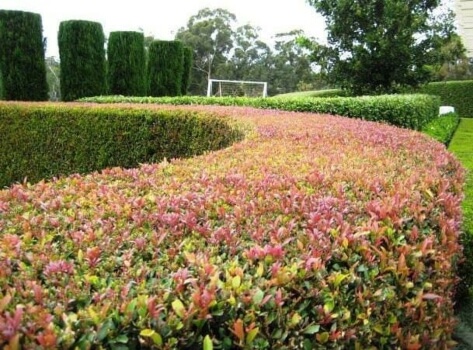Acmena smithii is one of the most popular lilly pilly species thanks to its all-around stunning features and multitude of uses within landscapes. This widely distributed native features creamy-white flowers borne in panicles on branches, brilliant flushes of pink new growth, smooth-green waxy leaves and white to deep-red decorative berries.
Its bark is rough and woody and its growth habit is compact and dense, making it an excellent specimen tree, hedge or topiary plant. Here is your comprehensive guide to growing and caring for this beloved Australian native in your garden.
More...
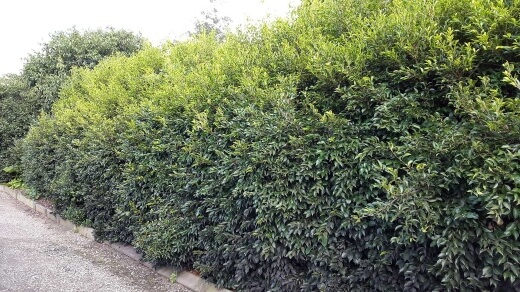
Source: alpinenurseries.com.au
Family: | Myrtaceae |
|---|---|
Genus: | Acmena |
Species: | A. smithii |
New name: | Syzygium smithii |
Common names: | Lilly Pilly, Monkey Apple |
Location: | Outdoor |
Type: | Small tree, large shrub |
Growth: | 3 to 5 metres tall, 1 to 3 metres wide |
Sun requirements: | Full sun to heavy shade |
Foliage colour: | Green |
Flower colour: | White to cream |
Flowering: | Spring to summer |
Fruit: | Non-edible white to red berries in late summer to winter |
Maintenance level: | Low |
Poisonous for pets: | Non-toxic to cats and dogs |
This summer-flowering, winter-fruiting evergreen can be grown as both a small tree and a large shrub, offering growers many practical and ornamental applications within their gardens.
The plant shares its common name lilly pilly with many other species in its genus and it has gained such popularity across Australia thanks to its decorative foliage, fruits and flowers.
Though this particular species of lilly pilly grows unpalatable fruits, it is one of the most attractive in its family so it will be able to add luscious pops of colour year-round to any garden setting.
What is Lilly Pilly Acmena smithii?
Now renamed Syzygium smithii, Acmena and Eugenia are both former botanical names for the genus. Acmena smithii forms a part of the myrtle family of flowering plants, Myrtaceae and is native to the coastlines and rainforests of Queensland, New South Wales and Victoria.
This species can thrive in most of our endemic climates including sub-tropical, warm temperate, cool temperate and Mediterranean zones so it is a great pick for most Aussie gardens.
Acmena Lilly Pilly's Natural Habitat
In its natural habitat, the plant can reach up to 20 metres tall but in cultivation, it will grow at a fast rate to about 3 to 5 metres tall and 1 to 3 metres wide unpruned.
As it responds so well to pruning, it can be kept smaller so you can easily establish this plant regardless of your garden’s setting or size. The fruits and flowers will attract local birdlife, bees and butterflies.
Common landscaping applications include:
- Low-maintenance garden filling for beds
- Poolside specimen
- Coastal garden shrub - find out more about coastal gardening here.
- Container grown plant
- Feature tree or shrub for larger gardens
- Attractive hedge or screen
- Windbreak
Most Popular Acmena smithii Cultivars
Acmena smithii ‘Allyn Magic’

Source: gardeningwithangus.com.au
Being a compact cultivar, this plant is perfect for smaller gardens or growers who are looking at establishing a lower-growing hedge. It features greyed-orange new growth with a gorgeous combination of cream, pink and green leaves, making this cultivar truly ornamental and striking in landscapes.
Acmena smithii ‘Cherry Surprise’
As its name suggests, this variety features bold burgundy new growth that resembles deep cherry tones in the foliage. It has a compact growth habit and is taller growing than the original Acmena smithii, making it a fantastic hedging specimen for taller hedges or screens.
Acmena smithii ‘Firescreen’
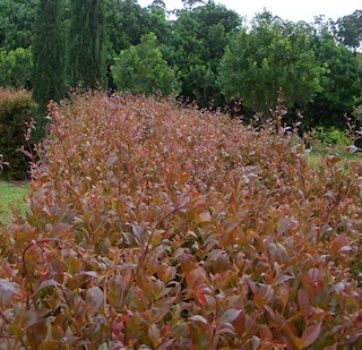
Source: sydneyplantmarket.com.au
A very select, fast-growing and broadleaf cultivar. It features glossy coppery-red new growth and is easily encouraged by orderly pruning and feeding.
Unpruned, this cultivar will grow to over 6 metres tall so it is perfect for hedging from 1.5 metres high. Thanks to its dense form, it can be grown in large pots or used as an excellent topiary specimen in front or backyards.
This variety was bred to be resistant to wind, heat waves, frost down to -2°C and attack from psyllids.
Acmena smithii ‘Red Head’
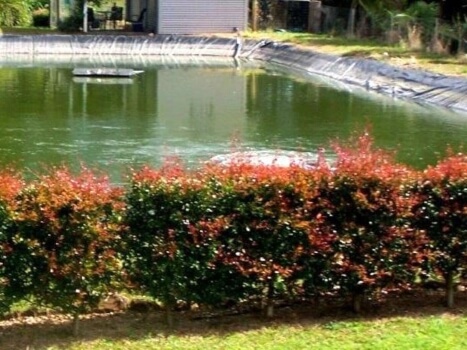
Source: plantmark.com.au
Another select, broadleaf cultivar, this plant will usually grow as more of a tree than a shrub. It also produces exciting burgundy-red new foliage that matures to dark, glossy green.
Unpruned, it will grow to over 8 metres tall so it is a good option for those looking for a larger growing Acmena smithii variety. It is perfect for tall hedges or large topiary projects within gardens. It features the same resilience as the ‘Firescreen’ cultivar.
It is important to note that not all these cultivars may be available in your area. Be sure to look online or enquire with your local professionals if you need help finding a specific variety.
How to Grow Acmena smithii
Propagation of this species is best done using seeds or cuttings. Seeds can be slow to germinate where cuttings will strike relatively quickly and will also produce more true-to-type plants than seeds.
For any specific cultivars, it is best to purchase young and healthy nursery plants from reputable suppliers to ensure you are growing a specifically bred variety.
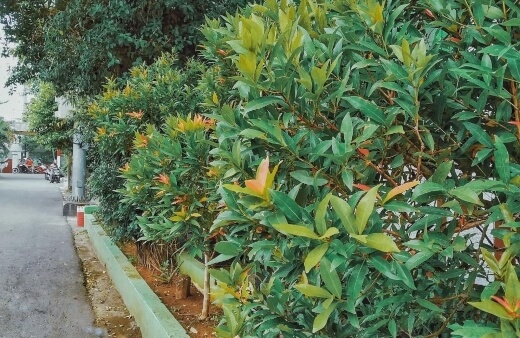
Growing Acmena smithii from Seeds
Collect fresh fruits from your plant as they ripen then gently remove the flesh and clean the seeds to remove any debris. Prepare well-draining seed trays or individual pots and fill them with a high-quality potting or seedling mix. (Check out these biodegradable pots for reference).
Sow your seeds into the mix then water lightly. Keep your seeds in a warm and humid location away from harsh light or strong winds. Keep the propagation mix moist but not wet and your seeds should germinate as soon as conditions are optimal.
Sow seeds in spring to summer for the best results.
Growing Monkey Apple from Cuttings
Using a sharp and sterilised pair of secateurs (Pick the best secateurs if you need one here), take 10cm long cuttings of new growth in spring or early summer.
The cuttings should just be hardening for the best results. Gently remove the lower leaves and trim the top leaves back by about half. Dip the cut end of the cuttings into a quality rooting hormone then plant each cutting into its own pot or container filled with a quality potting mix.
Water lightly after planting then be sure to keep the mix moist but never wet. The cuttings should be placed in a warm, humid location away from direct light or strong drafts.
Once the cuttings have rooted and started to produce new growth, you can gradually move them into larger containers until they are big enough to be transplanted into the garden.
Learn more on taking cuttings, and which to use depending on what plant you’re getting it from here.
Planting Condition and Tips for Acmena smithii
This tough and adaptable plant can certainly thrive in many different environments and growing conditions. As it does feature an invasive root system when established, be sure to plant yours at least 20 metres clear of any sewage or water mains.
Here are some of the ideal conditions for planting Acmena smithii that will ensure you have a happy and healthy plant.
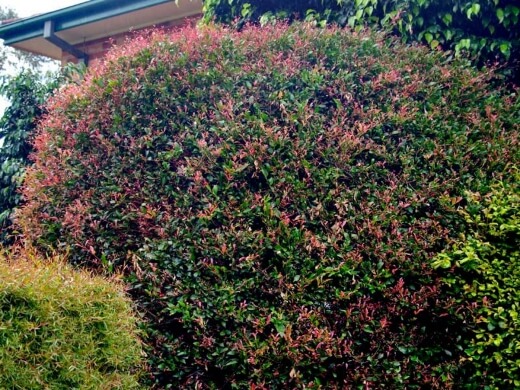
Source: gardensonline.com.au
Soil Preferences
This plant can tolerate many soil types but prefers moderately moist and well-draining soil. Due to the extensive roots, it should also be planted in deep soil. You can use sandy, clay, loam or even poor soils for your plant.
A combination of these can also work great. For container-grown specimens, be sure to use a high-quality potting mix for the best results. Soil pH can be neutral, acidic or alkaline.
Lighting Needs for Best Growth
This exceptional species of lilly pilly can thrive, fruit and flower prolifically in full sun to even fully shaded positions. Though heavy shade may lead to slower growth, the plant should do just fine given any lighting conditions provided it gets some sun each day.
Hedging Tips for Acmena smithii
- It is recommended to dig a planting trench rather than individual holes when establishing a hedge.
- Fill your trench with loose and premium soil so that the roots can easily grow and spread.
- Generally, the larger your root balls and plants are, the further away they should be spaced. For instance, a lower growing hedge that reaches 1 to 1.5 metres tall should be spaced about 50cm apart while taller varieties that reach over 1.5 metres tall should be spaced about a metre apart.
- Adding some organic compost and a slow-release fertiliser to your hedging soil before planting can boost initial growth and allow for your hedge to be established a little quicker.
- Be sure to water well before and after planting.
Find out the most popular Australian native hedging plants here
Caring for Acmena smithii Correctly
Once established within your garden, your plant will be drought tolerant and handle moderate frost. Overall, this species of lilly pilly doesn’t require much hassle so you can be sure you won’t have to sweat to have a thriving plant.
Here are some of our care tips for Acmena smithii.

Source: plantmark.com.au
Fertilising & Feeding
It is best to feed your plant at least once annually with a quality controlled-release fertiliser. Feed in spring just before its active season begins for bountiful blooms and fruits.
Though not necessary, you can also choose to use a more organic native blend.
Watering Acmena smithii
During the warmer months when the plant is actively growing, it will enjoy reliable moisture over this period so be sure to keep your plant well-watered in summer.
You can cut back on watering during Autumn and more so in winter.
Pruning Properly
Depending on how you choose to grow your plant, pruning can differ slightly. For stand-alone feature plants or topiary specimens, pruning occasionally can do wonders.
If needed, this plant can even be hard pruned so don’t be afraid to prune them into shape as needed when they become unruly. For hedge pruning, it is better to tip-prune more frequently to maintain an attractive appearance and density.
It is recommended to prune this plant after a new growth flush. Be sure to always use a sharp and sterilised pair of pruning shears.
Here are the best hedge shears we reviewed for 2024.
Mulching Matters
Be sure to keep your plant or hedge well mulched, especially in the summer months. This will encourage good moisture retention, will suppress weeds and it will further contribute to healthy flowering and fruiting. Organic-based mulches tend to perform better.
See our ultimate guide on mulches, its types, and when to use them here.
General Clean-Up
After flowering and fruiting in the late summer months, fallen fruits, seedpods and spent flowers may need to be collected and cleared, especially around pathways, decks or the poolside.
If you like, you can always prune off spent flower heads directly after flowering to avoid masses of fruits from forming.
Acmena smithii Possible Pests & Diseases
Luckily, this species is resistant to many of the common issues that plague Lilly Pillies such as psyllids and root rot. Some smaller problems can become frustrating in certain conditions but these are also dealt with quite easily.
Scale Insects
These small sap-sucking pests will slowly munch away on the foliage. They are usually found on the undersides of the leaves and the stems. To treat them, you can manually spray them off using a mixture of soap and water.
You can also use an organic insecticide for larger infestations or neem oil always tends to deter these critters. As this plant responds so well to pruning, you can also simply prune away infested branches to minimise the impact.
Myrtle Rust
Unfortunately, on rare occasions, this plant can fall victim to myrtle rust which is a common fungal disease that heavily affects many species in this family of plants.
Though most new breeds are being developed to be resistant to this condition, some plants may still fall ill. For smaller infections, use a quality fungicide and prune off any infected foliage as needed.
Larger infections will most likely be lethal as there are no definitive cures yet for myrtle rust. Be sure to remove and dispose of heavily infected planted off property to avoid the disease from spreading to other vegetation.
Acmena smithii Frequently Asked Questions
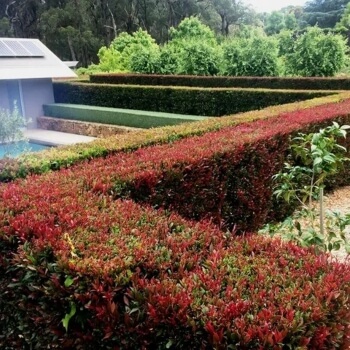
Source: warners.com.au
How fast does Acmena smithii grow?
The growth rate is medium to fast depending on the conditions but on average, it will grow around 0.5 to 0.75 metres per year.
How long does a lilly pilly live?
Most species in this genus live for approximately 20 years.
How can I make my lilly pilly grow faster?
Add a side-dressing of quality composted manure to your plants at least every spring. Water this in well. Be sure to also feed with a slow-release organic fertiliser at least once to twice per annum.
How often should I water lilly pilly plants?
On average, water about 2 to 3 times per week in the warmer months then cut back as needed while temperatures drop.
Interested in establishing other fantastic lilly pilly varieties in your landscape? Well, you’re in luck as we have many comprehensive growing guides for these adored natives. Check out some of them below for reference:
Accentuate and Elevate Your Gardens Appeal with Acmena smithii
Being one of our more favoured and cultivated species of lilly pilly, Acmena smithii is the perfect pick for so many scenarios. Whether it's hedging, topiary projects or simply a highly ornamental feature you’re looking for, this plant will certainly impress.
With its striking new growth, profuse flowering and decorative fruits, this shrub will add luscious texture and colour to your landscape almost year-round.
While also being so easy to grow and care for, it's an excellent choice for any grower regardless of experience. Elevate the native wonder in your garden with the fully charming Acmena smithii.
Published on August 27, 2022 by Lorri Hopkins
Last Updated on February 22, 2024

